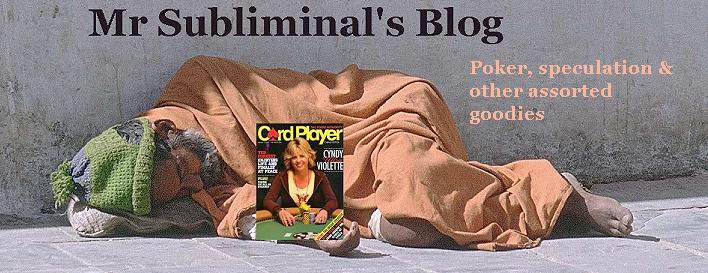The Station casinos are rewarding 50 hours of play in April and May with a $200,000 freeroll tournament. In a bid to chalk up a few hours, I found myself sitting at a $1-$2 NL table at the Green Valley Ranch. Most of the players were locals with an even balance between loose aggressives and tight passives.
With about $130 in front of me, I open limp from early position with 99. There are 5 callers including the button and the blinds. The flop comes
Q T 9 with 2 hearts
I check, player to my left bets $10, next player folds, button raises to $25 and the blinds fold. I think there's at least a 50% chance the button has me beat and I put the initial bettor on a flush draw.
I push (both my opponents have me covered), the initial bettor folds and the button calls after about 10 seconds of deliberation. He shows the nuts (KJo) and takes down the pot when I fail to improve.
Should I just have called the button's raise instead of pushing? An examination of my pot equity reveals an interesting phenomenom. If it is 2-handed between the button and myself and we assume he has the straight, my pot equity is 35%. If it is 3-handed and we assume the initial bettor is on a flush draw, my pot equity not only doesn't decrease, it actually increases to 35.5%, with the button giving up 26% equity to the flush draw. This apparent paradox is explained by Morton's Theorem. I have yet to factor in other variables such as fold equity and the probability that the button actually does have the straight.
The aim here is to maximize my winnings and I'm not so sure I did.
Tuesday, April 18, 2006
Classic misplay?
Posted by
Mr Subliminal
at
12:14 PM
![]()
Subscribe to:
Post Comments (Atom)




3 comments:
For the question about maximizing profit, what % of the time to you believe the person with KJ would have folded if the board would have paired on the turn after calling his flop bet?
If the stacks are not deep (under 100BBs) I'd feel a push would be correct to maximize your win.
Thanks for your comments, Drizz. My instinct was to push and this is backed up by a crude calculation showing me as a 55% favorite after the flop, using the assumptions in the post. I suppose the lesson here is that, all other things being equal, there was no need to thin the field out.
I like the push on the flop too. That's a very draw heavy board. If a 10, K, 8, or heart comes on the turn, you're not going to know where you stand if you've simply called the flop bet. Also, I discount the chance that you're up against the nuts, as you'd expect that player to be more likely to attempt a slow play. And if you're up against a higher set, well, you're probably going to lose all of your money anyway.
Post a Comment